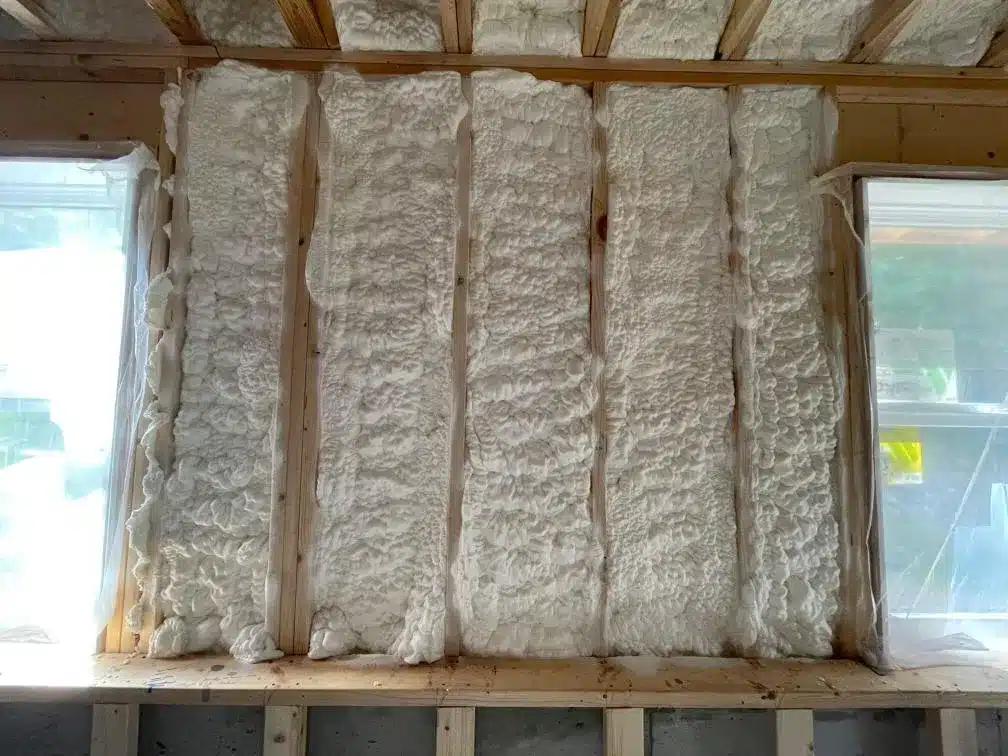Open-cell spray foam is a popular insulation choice for many homes and commercial buildings in Medford, OR. It offers excellent energy efficiency, sound absorption, and air sealing capabilities. But what exactly goes into the production and application of this type of insulation? For property owners, builders, and developers across Medford, Ashland, Central Point, Eagle Point, and beyond, understanding this process can be a valuable step toward making informed decisions about building materials and methods. In this post, we’ll delve into what open-cell spray foam is, how it’s manufactured, and why it’s a top choice for insulation in Southern Oregon.
What is Open Cell Spray Foam?
Open-cell spray foam is an insulation with lower density and spongy texture. Unlike closed-cell spray foam, which is more rigid, open-cell foam expands significantly once sprayed, filling cracks, crevices, and voids. This expansion creates a highly effective seal that prevents air leaks, significantly improving energy efficiency in homes and businesses. The benefits of open-cell spray foam include:
- Improved energy efficiency by sealing air leaks
- Sound dampening qualities due to its open-cell structure
- Moisture control for improved indoor air quality
- Cost-effectiveness when compared to other types of spray foam
Understanding open-cell spray foam’s manufacturing and application process is critical to understanding why it is so effective and suitable for many projects in Medford and surrounding areas.
The Ingredients of Open Cell Spray Foam
Open-cell spray foam is created through a chemical reaction involving two main components: isocyanate and a polyol resin mixture. These two components are kept in separate containers until they can be combined during the spray application. Let’s break down each component and its role:
- Isocyanate: This reactive compound plays a crucial role in forming foam cells. It reacts with water in the polyol mixture to create bubbles, forming the foam’s expanded structure.
- Polyol Resin Mixture: The polyol resin contains blowing agents, surfactants, and water, essential for foam expansion and cell creation. The water reacts with the isocyanate to generate carbon dioxide, expanding the foam.
These materials are combined at the nozzle of a specialized spray foam gun, which allows the mixture to expand and fill the area effectively. Open cell foam typically expands to 100 times its original volume, making it ideal for hard-to-reach spaces and irregular cavities.
The Manufacturing Process Explained
1. Mixing and Preparation
The key to successful open-cell spray foam insulation in Medford, OR starts with careful preparation and mixing. The isocyanate and polyol resin components must be adequately stored and maintained at specific temperatures to create a uniform, high-quality product. A consistent storage condition can lead to consistency in the foam, resulting in subpar performance.
The components are mixed using specialized spray foam equipment. Once the isocyanate and polyol come into contact in the spray gun’s mixing chamber, they react almost instantly, expanding into the foam applied to walls, attics, and other surfaces.
2. Application Process
When applied, the mixed solution of isocyanate and polyol resin expands rapidly, allowing the foam to adhere to almost any surface—from wood to concrete. The application process includes several steps:
- Surface Preparation: Before applying the spray foam, it’s crucial to prepare the surfaces by cleaning them and ensuring they’re dry. This provides better adhesion and improved foam performance.
- Spraying the Foam: Using a spray gun, the technician sprays the foam into cavities, attics, or walls. The spray equipment keeps the temperature of the mixed solution within a precise range to ensure the foam maintains proper consistency.
- Foam Expansion: The foam starts to expand upon contact with the surface. Open-cell spray foam can develop as much as 100 times its original volume, seamlessly filling gaps, voids, and cracks.
- Curing: Open-cell spray foam takes about 24 hours to heal fully. It continues expanding and forming its final structure during this time, creating a soft, sponge-like consistency.
3. Quality Control and Inspection
After the application is complete, a thorough inspection is essential. Proper curing and application ensure that the insulation has no gaps or inconsistencies, which could lead to air leaks or a reduction in thermal performance.
Advantages of Open Cell Spray Foam
For property owners in Medford and surrounding areas, open-cell spray foam offers several advantages:
- Energy Efficiency: Open-cell spray foam creates a highly effective air seal, helping maintain indoor temperatures and reducing energy costs.
- Soundproofing: Its open-cell structure makes it excellent for sound insulation and ideal for homes or businesses in noisy areas.
- Vapor Permeability: Unlike closed-cell foam, open-cell foam is vapor-permeable, allowing moisture to move through it. This can help manage humidity levels inside the building.
- Affordability: Open-cell foam is generally more cost-effective than closed-cell foam, making it an excellent choice for those seeking quality insulation on a budget.
Applications of Open Cell Spray Foam
Open-cell spray foam is highly versatile and can be used in various locations within both residential and commercial properties. Some typical applications include:
- Attics and Loft Spaces: Open-cell foam is commonly used in attics to prevent air movement and improve overall energy efficiency effectively.
- Interior Walls: Its sound-dampening qualities make it ideal for use between rooms, offering privacy and noise control.
- Crawl Spaces: It provides excellent insulation in crawl spaces, reducing the risk of mold growth and improving indoor air quality.
- Renovation Projects: Open-cell foam’s flexibility and expansion ability make it perfect for irregularly shaped areas and existing structures during renovations.
Is Open Cell Spray Foam Right for Your Project?
If you’re a property owner, builder, or developer in Medford or surrounding areas, you might wonder if open-cell spray foam is the right choice for your insulation needs. Here are some considerations:
- Budget: Open-cell spray foam tends to be more affordable than closed-cell foam while still offering a high level of performance, making it an excellent choice for projects with tight budgets.
- Location: Open-cell spray foam is an excellent choice for insuring interior walls or attics. However, closed-cell spray foam may be better suited for applications requiring high moisture resistance, such as basements or external walls.
- Sound Control: Open-cell foam excels in areas where sound control is a priority, such as between rooms or buildings with high noise levels.
Common Myths about Open Cell Spray Foam
There are a few misconceptions about open-cell spray foam that we’d like to clarify:
- Myth 1: Open-cell spray foam needs to be more durable.
- Fact: Open-cell spray foam can last the structure’s lifetime when properly installed. It maintains its shape and effectiveness without sagging or deteriorating.
- Myth 2: Open-cell foam doesn’t provide enough insulation.
- Fact: Open-cell foam has a lower R-value per inch than closed-cell foam but still provides highly effective insulation when used in suitable applications.
- Myth 3: Spray foam is harmful to indoor air quality.
- Fact: Once cured, open-cell spray foam does not emit harmful chemicals. It helps improve indoor air quality by sealing out pollutants and allergens.
Why Choose All Foam & Insulation for Your Insulation Needs?
Choosing the right contractor is crucial to ensuring high-quality results if considering upgrading or installing insulation on your property. All Foam & Insulation specializes in open-cell spray foam, closed-cell spray foam, fiberglass batt insulation, blown-in insulation, and membrane roofing. We serve Medford, Ashland, Central Point, Eagle Point, Grants Pass, Roseburg, White City, and the surrounding areas, offering:
- Experienced Technicians: Our technicians are highly trained and experienced in handling all types of insulation.
- Commitment to Quality: We use the highest quality materials to ensure your property stays comfortable and energy-efficient year-round.
- Local Expertise: Being local means we understand Oregon’s unique climate challenges and use our expertise to recommend the best insulation solutions for your property.
Ready to Improve Your Property’s Comfort and Efficiency?
Open cell spray foam is a practical, versatile, and affordable insulation solution for property owners in Medford, OR, and the surrounding areas. Whether you are planning a new construction project, renovating an older property, or simply looking to improve the comfort and efficiency of your space, our team is here to help.
Call us today at (541) 826-9600, or visit our website at https://allfoamandinsulation.com/. You can also email us at [email protected] for more information or to schedule a consultation.
We’re ready to assist you with all your insulation needs, helping you create a comfortable, energy-efficient environment in your home or commercial property.
Frequently Asked Questions
1. What are the main components of open-cell spray foam?
Open-cell spray foam is made from isocyanate and a polyol resin mixture, which reacts to create the foam.
2. How does open-cell spray foam expand during application?
When sprayed, the foam expands up to 100 times its original volume, filling gaps and improving insulation.
3. How long does it take for open-cell spray foam to cure?
Open cell spray foam typically takes about 24 hours to cure after application fully.
4. What are the key benefits of open-cell spray foam insulation?
It improves energy efficiency, dampens sound, and is more cost-effective than other insulation types.



